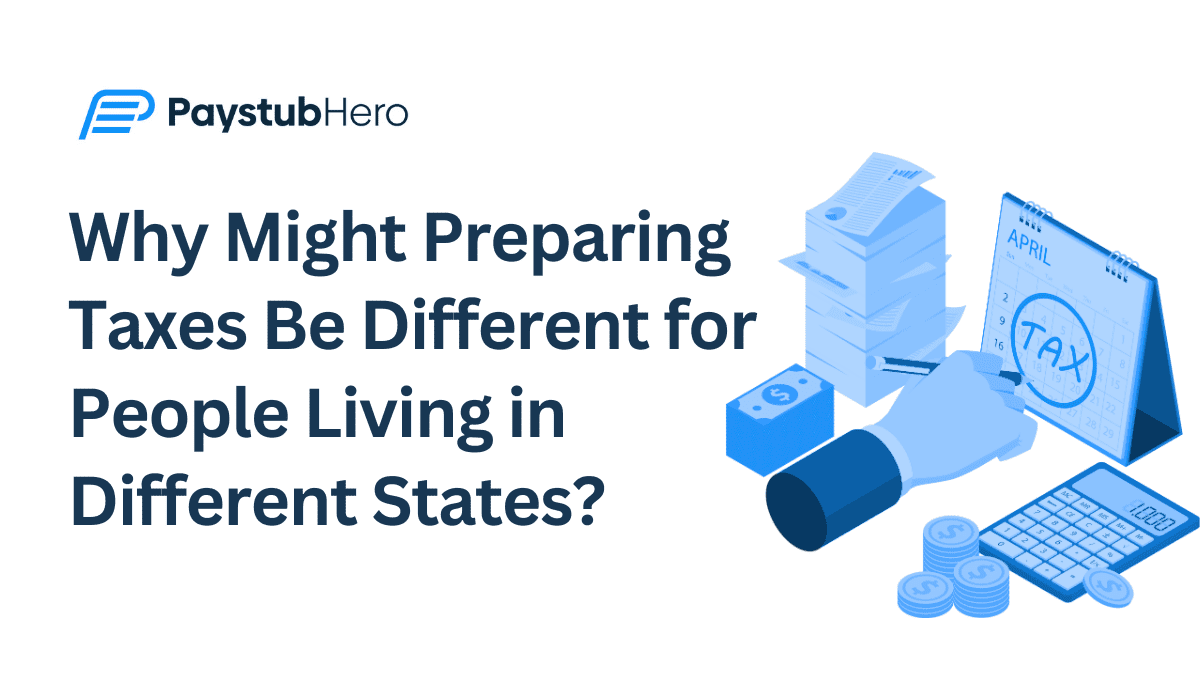Tax season comes every year, but filing taxes can vary based on where you live.
Moving between states or working in multiple states reveals differences in tax rules. Some states have income taxes, while others don’t. Some offer deductions, while others have higher property taxes.
Here are the key reasons tax preparation differs across the U.S.
1. State Income Tax: Varying Rates and Exemptions
Taxes work differently depending on where you live, and one of the biggest reasons for this is state income tax. Or the lack of it. Some states don’t tax income at all, while others have different ways of collecting revenue.
Let’s break it down.
Right now, nine states don’t impose any income tax: Florida, Texas, Washington, Wyoming, Nevada, South Dakota, Alaska, Tennessee, and New Hampshire. If you live in one of these states, you don’t have to worry about state income tax deductions from your paycheck.
That sounds great, right? Well, these states often make up for it in other ways. You might pay higher sales tax, property tax, or other fees that help the state generate revenue.
Meanwhile, states like California, New York, and Oregon have a progressive tax system.
The federal government uses a progressive tax system, meaning higher income earners pay a higher percentage of their earnings.
Below is the federal income tax bracket for 2024:
As you can see, your tax rate depends on how much you earn and your filing status. It varies based on whether you’re single, married, or filing as head of household.
This means that even if you live in a state with no income tax, you’ll still need to consider your federal tax obligations.
2. Deductions and Credits Vary by State
When it comes to taxes, federal deductions and credits apply across all states.
However, state-specific deductions and credits vary widely. And these differences can have a big impact on how much you owe. Or how much you get back in a refund.
Some states offer generous tax breaks, while others provide very few incentives.
Why Do States Offer Different Deductions and Credits?
States use tax incentives to encourage behaviors that benefit their economies or social programs. This could mean rewarding homeowners, easing the burden of education costs, or helping with medical expenses.
Here are a few key areas where state tax benefits differ:
➡ Homeownership
Some states, such as New York and California, offer deductions for mortgage interest or property taxes paid. These deductions can provide significant relief, especially in high-cost housing markets.
Homeowners can deduct property taxes, but the Tax Cuts and Jobs Act limits these deductions to $10,000. This change affects homeowners in high-tax states, potentially reducing their tax savings.
The actual benefits vary based on income and local tax rates.
➡ Education Expenses
Many states provide tax credits for tuition payments, student loan interest, or contributions to 529 college savings plans.
For example, Indiana offers a 20% tax credit (up to $1,500) for contributions to a 529 plan, encouraging families to save for education.
➡ Medical Costs
While federal tax law allows deductions for medical expenses exceeding 7.5% of adjusted gross income, some states set lower thresholds, making it easier to deduct these costs.
According to the National Conference of State Legislatures, states like Massachusetts and New Jersey allow broader deductions for out-of-pocket medical expenses.
3. Sales and Property Taxes: The Hidden Costs
While some states forego income tax, they often compensate with higher sales and property taxes. This means that even if you don’t pay income tax, your overall tax burden may still be high.
Take California, which has a state sales tax of 7.25%, among the highest in the country.
Meanwhile, Oregon and New Hampshire impose no sales tax at all. If you live in a high-sales-tax state, everyday purchases, such as groceries, electronics, and dining will cost more over time.
Similarly, property taxes vary significantly.
New Jersey has some of the highest property tax rates, while Hawaii and Alabama have some of the lowest. This can greatly impact homeowners, especially those purchasing real estate in high-tax areas.
For renters, this could mean landlords pass on the tax burden through higher rent prices. When considering moving to another state, factoring in these additional costs is crucial.
How States Compare on Sales and Property Taxes
State | State Sales Tax (%) | Average Property Tax Rate (%) | No State Income Tax? |
California | 7.25% | 0.71% | ❌ No |
Oregon | 0% | 0.86% | ✅ Yes |
New Hampshire | 0% | 1.89% | ✅ Yes |
Texas | 6.25% | 1.63% | ✅ Yes |
New Jersey | 6.625% | 2.33% | ❌ No |
Hawaii | 4.00% | 0.27% | ❌ No |
Alabama | 4.00% | 0.36% | ❌ No |
4. Filing Rules and Deadlines Vary by State
Federal taxes are due on April 15, but state tax deadlines vary. Some states match the federal date, while others provide extensions.
For example, California extended its 2023 state tax deadline to October 16 due to natural disasters, while Iowa sets its deadline on April 30 instead of April 15.
These differences can impact when you need to file and pay.
Unique State Filing Requirements
Each state has its own rules that go beyond just deadlines. Here are a few key differences:
⦿ Mandatory Filing
Some states require all residents to file a return, even if they owe no tax. For instance, Massachusetts requires a return if income exceeds $8,000.
⦿ Automatic Extensions
Certain states grant extra time if you’ve already filed for a federal extension. New York and Texas automatically follow federal extensions without requiring separate paperwork.
⦿ Additional Documentation
Some states demand extra proof before processing returns. Louisiana, for example, requires proof of residency if there’s a change in address.
Failing to meet these requirements could result in late fees, processing delays, or missed refunds.
5. Local Taxes Add Another Layer of Complexity
Beyond state taxes, some cities and counties impose additional levies. If you live in New York City or Philadelphia, you might pay local income tax in addition to state and federal taxes.
Other local taxes include:
⦿ Occupational Taxes – Certain cities impose taxes based on specific job industries.
⦿ Transit Taxes – Some regions implement taxes to fund public transportation systems.
⦿ Tourism-Related Taxes – If you work in the hospitality sector, extra taxes may apply.
This means that where you live within a state matters just as much as which state you reside in. Even two cities within the same state may have vastly different tax implications.
6. Working or Moving Across State Lines Complicates Taxes
If you live in one state but work in another, or if you relocate mid-year, your tax situation becomes more complicated. Many states have reciprocity agreements, meaning residents working in neighboring states only pay taxes in their home state.
However, this isn’t always the case.
For instance:
⦿ If you live in New Jersey but work in New York, you may owe taxes to both states.
⦿ If you move from California to Texas halfway through the year, you must file as a part-year resident in California and report income earned before your move.
Multi-state tax filings require extra paperwork, making tax preparation more time-consuming. It’s essential to carefully document income sources and residency periods to ensure accurate filings.
7. Remote Work: A New Tax Challenge
The rise of remote work has introduced new tax complexities. Some states tax income based on where the work is performed, while others tax based on where the employer is located.
For instance, New York has a “convenience of the employer” rule, meaning that if you work remotely for a New York-based company from another state, you may still owe New York state taxes. This rule can lead to unintended double taxation if your home state also taxes your income.
Remote workers need to be mindful of these regulations and possibly seek professional guidance to avoid overpaying taxes.
Simplify Your Tax Season: Generate Accurate Paystubs & Essential Tax Documents with PaystubHero Today!
Navigating these varying tax rules can be challenging, but having the right tools can make all the difference.
With PaystubHero, you can effortlessly generate accurate paystubs and essential tax documents, ensuring you have everything you need—no matter where you live.
Simplify your tax season and stay organized with PaystubHero today!
FAQs
Frequently asked questions about why tax preparation varies for residents across different states include:
Yes, if you moved to a new state during the year, you may have to file a part-year resident return in both states. Each state will tax the income you earned while you were a resident there.
Not necessarily. Many states have reciprocity agreements, meaning you only pay taxes in your home state, even if you work elsewhere.
State tax laws vary. With a reciprocity agreement, you pay only in your home state. Without one, you may owe non-resident taxes but get a credit.
You must file in two states if you moved and earned income in both, worked in a non-reciprocity state, or earned rental or investment income in another state.
State tax laws vary. With a reciprocity agreement, you pay taxes where you live. Without one, you may owe non-resident taxes where you work and still file in your home state.
Yes, it’s possible, but most states prevent this through tax credits. If you owe taxes in both states, your home state will usually provide a credit for taxes paid to another state, reducing or eliminating double taxation.





